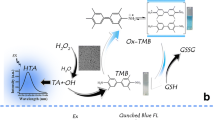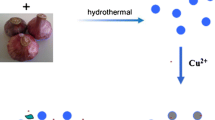Abstract
The application of carbon dots as a coreactant for Ru(bpy)32+ (where bpy is 2,2′-bipyridine) electrochemiluminescence (ECL) has been widely studied. However, the high cost of Ru(bpy)32+ and its derivatives has prohibited its widespread use in ECL biosensors. Herein, a novel anodic ECL system based on sulfur-doped graphitic carbon nitride nanosheets (S-g-C3N4 NSs) and nitrogen-doped carbon dots (N-CDs) is presented. In this ECL system, N-CDs serve as a new ECL coreactant that can significantly enhance the anodic ECL signal of S-g-C3N4 NSs (approximately 83 times) under optimal conditions. The possible ECL response mechanism of the S-g-C3N4 NSs/N-CDs system is proposed in detail on the basis of cyclic voltammograms, ECL–time curves, and ECL spectra. Furthermore, the ECL signal of the S-g-C3N4 NSs/N-CDs system was quenched by folic acid (FA), which was chosen as a model analyte to study the potential application of the new ECL system. The ECL intensity decreased linearly with the concentration of FA in the range from 0.05 to 200 μM. The detection limit for FA measurement is 16 nM (signal-to-noise ratio of 3). The proposed new ECL system has many advantages over traditional approaches, such as low toxicity and excellent biocompatibility. Especially, the proposed approach can detect FA in diluted human serum samples with satisfactory recoveries, indicating promising application for bioanalysis.

Graphical abstract






Similar content being viewed by others
References
Richter MM. Electrochemiluminescence (ECL). Chem Rev. 2004;104(6):3003–36.
Miao W. Electrogenerated chemiluminescence and its biorelated applications. Chem Rev. 2008;108(7):2506–53.
Tan X, Zhang B, Zhou J, Zou G. Spectrum-based electrochemiluminescence immunoassay for selectively determining CA125 in greenish waveband. ChemElectroChem. 2017;4(7):1714–8.
Wei Y, Wang Y, Wang J, Yang X, Qi H, Gao Q, et al. Homogeneous electrogenerated chemiluminescence immunoassay for the detection of biomarkers by magnetic preconcentration on a magnetic electrode. Anal Bioanal Chem. 2019;411(18):4203–11. https://doi.org/10.1007/s00216-019-01830-1.
Yuan J, Wang E. Effects of divalent metal ions on electrochemiluminescence sensor with Ru(bpy)3 2+ immobilized in Eastman-AQ membrane. Electroanalysis. 2008;20(9):949–54.
Jiang D, Du X, Liu Q, Zhou L, Qian J, Wang K. One-step thermal-treatment route to fabricate well-dispersed ZnO nanocrystals on nitrogen-doped graphene for enhanced electrochemiluminescence and ultrasensitive detection of pentachlorophenol. ACS Appl Mater Interfaces. 2015;7(5):3093–100.
Li L, Chen Y, Zhu JJ. Recent advances in electrochemiluminescence analysis. Anal Chem. 2017;89(1):358–71.
Ding Z, Quinn BM, Haram SK, Pell LE, Korgel BA, Bard AJ. Electrochemistry and electrogenerated chemiluminescence from silicon nanocrystal quantum dots. Science. 2002;296(5571):1293–7.
Yu Y, Lu C, Zhang M. Gold nanoclusters@Ru(bpy)3 2+-layered double hydroxide ultrathin film as a cathodic electrochemiluminescence resonance energy transfer probe. Anal Chem. 2015;87(15):8026–32.
Zhang L, Shang L, Dong S. Sensitive and selective determination of Cu2+ by electrochemiluminescence of CdTe quantum dots. Electrochem Commun. 2008;10(10):1452–4.
Jie G, Huang H, Sun X, Zhu J-J. Electrochemiluminescence of CdSe quantum dots for immunosensing of human prealbumin. Biosens Bioelectron. 2008;23(12):1896–9.
Hesari M, Swanick KN, Lu JS, Whyte R, Wang S, Ding Z. Highly efficient dual-color electrochemiluminescence from BODIPY-capped PbS nanocrystals. J Am Chem Soc. 2015;137(35):11266–9.
Zhang X, Xie X, Wang H, Zhang J, Pan B, Xie Y. Enhanced photoresponsive ultrathin graphitic-phase C3N4 nanosheets for bioimaging. J Am Chem Soc. 2013;135(1):18–21.
Cheng C, Huang Y, Tian X, Zheng B, Li Y, Yuan H, et al. Electrogenerated chemiluminescence behavior of graphite-like carbon nitride and its application in selective sensing Cu2+. Anal Chem. 2012;84(11):4754–9.
Xiong M, Rong Q, Meng HM, Zhang XB. Two-dimensional graphitic carbon nitride nanosheets for biosensing applications. Biosens Bioelectron. 2017;89(15):212–23.
Zhu R, Zhang Y, Fang X, Cui X, Wang J, Yue C, et al. In situ sulfur-doped graphitic carbon nitride nanosheets with enhanced electrogenerated chemiluminescence used for sensitive and selective sensing of L-cysteine. J Mater Chem B. 2019;7(14):2320–9.
Hai Z, Li J, Wu J, Xu J, Liang G. Alkaline phosphatase-triggered simultaneous hydrogelation and chemiluminescence. J Am Chem Soc. 2017;139(3):1041–4.
Zhai Q, Li J, Wang E. Recent advances based on nanomaterials as electrochemiluminescence probes for the fabrication of sensors. ChemElectroChem. 2017;4(7):1639–50.
Chen H, Li W, Zhao P, Nie Z, Yao S. A CdTe/CdS quantum dots amplified graphene quantum dots anodic electrochemiluminescence platform and the application for ascorbic acid detection in fruits. Electrochim Acta. 2015;178:407–13.
Liu X, Shi L, Niu W, Li H, Xu G. Environmentally friendly and highly sensitive ruthenium(II) tris(2,2'-bipyridyl) electrochemiluminescent system using 2-(Dibutylamino)ethanol as co-reactant. Angew Chem Int Ed. 2007;119(3):425–8.
Zhu S, Meng Q, Wang L, Zhang J, Song Y, Jin H, et al. Highly photoluminescent carbon dots for multicolor patterning, sensors, and bioimaging. Angew Chem Int Ed. 2013;52(14):3953–7.
Liu Y, Zhou Q, Li J, Lei M, Yan X. Selective and sensitive chemosensor for lead ions using fluorescent carbon dots prepared from chocolate by one-step hydrothermal method. Sensors Actuators B Chem. 2016;237:597–604.
Liu Y, Zhou Q, Yuan Y, Wu Y. Hydrothermal synthesis of fluorescent carbon dots from sodium citrate and polyacrylamide and their highly selective detection of lead and pyrophosphate. Carbon. 2017;115:550–60.
Jimenez-Ruiz A, Grueso E, Perez-Tejeda P, Muriel-Delgado F, Torres-Marquez C. Electrochemiluminescent (ECL) [Ru(bpy)3]2+/PAMAM dendrimer reactions: coreactant effect and 5-fluorouracil/dendrimer complex formation. Anal Bioanal Chem. 2016;408(25):7213–24.
Long YM, Bao L, Zhao JY, Zhang ZL, Pang DW. Revealing carbon nanodots as coreactants of the anodic electrochemiluminescence of Ru(bpy)3 2+. Anal Chem. 2014;86(15):7224–8.
Li L, Yu B, Zhang X, You T. A novel electrochemiluminescence sensor based on Ru(bpy)3 2+/N-doped carbon nanodots system for the detection of bisphenol A. Anal Chim Acta. 2015;895:104–11.
Li L, Liu D, Mao H, You T. Multifunctional solid-state electrochemiluminescence sensing platform based on poly(ethylenimine) capped N-doped carbon dots as novel co-reactant. Biosens Bioelectron. 2017;89(Pt 1:489–95.
Qi B-P, Zhang X, Shang B-B, Xiang D, Qu W, Zhang S. A facile method to sensitively monitor chlorinated phenols based on Ru(bpy)3 2+ electrochemiluminescent system using graphene quantum dots as coreactants. Carbon. 2017;121:72–8.
Xing H, Zhai Q, Zhang X, Li J, Wang E. Boron nitride quantum dots as efficient coreactant for enhanced electrochemiluminescence of ruthenium(II) tris(2,2'-bipyridyl). Anal Chem. 2018;90(3):2141–7.
Carrara S, Arcudi F, Prato M, De Cola L. Amine-rich nitrogen-doped carbon nanodots as a platform for self-enhancing electrochemiluminescence. Angew Chem Int Ed. 2017;56(17):4757–61.
Li X, Tan X, Yan J, Hu Q, Wu J, Zhang H, et al. A sensitive electrochemiluminescence folic acid sensor based on a 3D graphene/CdSeTe/Ru(bpy)3 2+-doped silica nanocomposite modified electrode. Electrochim Acta. 2016;187:433–41.
Prasad BB, Tiwari MP, Madhuri R, Sharma PS. Development of a highly sensitive and selective hyphenated technique (molecularly imprinted micro-solid phase extraction fiber–molecularly imprinted polymer fiber sensor) for ultratrace analysis of folic acid. Anal Chim Acta. 2010;662(1):14–22.
Woo KS, Chook P, Lolin YI, Sanderson JE, Metreweli C, Celermajer DS. Folic acid improves arterial endothelial function in adults with hyperhomocystinemia. J Am Coll Cardiol. 1999;34(7):2002–6.
Wei S, Zhao F, Xu Z, Zeng B. Voltammetric determination of folic acid with a multi-walled carbon nanotube-modified gold electrode. Microchim Acta. 2006;152(3):285–90.
Li X, Wu X, Zhang F, Zhao B, Li Y. Label-free detection of folic acid using a sensitive fluorescent probe based on ovalbumin stabilized copper nanoclusters. Talanta. 2019;195:372–80.
Chekin F, Teodorescu F, Coffinier Y, Pan G-H, Barras A, Boukherroub R, et al. MoS2/reduced graphene oxide as active hybrid material for the electrochemical detection of folic acid in human serum. Biosens Bioelectron. 2016;85:807–13.
Xu Y, Liu J, Gao C, Wang E. Applications of carbon quantum dots in electrochemiluminescence: a mini review. Electrochem Commun. 2014;48:151–4.
Wang W, Lu YC, Huang H, Feng JJ, Chen JR, Wang AJ. Facile synthesis of water-soluble and biocompatible fluorescent nitrogen-doped carbon dots for cell imaging. Analyst. 2014;139(7):1692–6.
Wang L, Zhou HS. Green synthesis of luminescent nitrogen-doped carbon dots from milk and its imaging application. Anal Chem. 2014;86(18):8902–5.
Xu Y, Niu X, Zhang H, Xu L, Zhao S, Chen H, et al. Switch-on fluorescence sensing of glutathione in food samples based on a graphitic carbon nitride quantum dot (g-CNQD)-Hg2+ chemosensor. J Agric Food Chem. 2015;63(6):1747–55.
S. Barbosa M, M. B. Oliveira F, Meng X, Soavi F, Santato C, O. Orlandi M. Tungsten oxide ion gel-gated transistors: how structural and electrochemical properties affect the doping mechanism. J Mater Chem C. 2018;6(8):1980–7.
Yang Z, Xu M, Liu Y, He F, Gao F, Su Y, et al. Nitrogen-doped, carbon-rich, highly photoluminescent carbon dots from ammonium citrate. Nanoscale. 2014;6(3):1890–5.
Wu ZL, Zhang P, Gao MX, Liu CF, Wang W, Leng F, et al. One-pot hydrothermal synthesis of highly luminescent nitrogen-doped amphoteric carbon dots for bioimaging from Bombyx mori silk – natural proteins. J Mater Chem B. 2013;1(22):2868.
Zhang Y, Fang X, Zhao H, Li Z. A highly sensitive and selective detection of Cr(VI) and ascorbic acid based on nitrogen-doped carbon dots. Talanta. 2018;181:318–25.
Li L-L, Ji J, Fei R, Wang C-Z, Lu Q, Zhang J-R, et al. A facile microwave avenue to electrochemiluminescent two-color graphene quantum dots. Adv Funct Mater. 2012;22(14):2971–9.
Cui R, Gu YP, Bao L, Zhao JY, Qi BP, Zhang ZL, et al. Near-infrared electrogenerated chemiluminescence of ultrasmall Ag2Se quantum dots for the detection of dopamine. Anal Chem. 2012;84(21):8932–5.
Qian J, Quan F, Zhao F, Wu C, Wang Z, Zhou L. Aconitic acid derived carbon dots: Conjugated interaction for the detection of folic acid and fluorescence targeted imaging of folate receptor overexpressed cancer cells. Sensors Actuators B Chem. 2018;262:444–51.
Gudarzy F, Moghaddam AB, Mozaffari S, Ganjkhanlou Y, Kazemzad M, Zahed R, et al. A lanthanide nanoparticle-based luminescent probe for folic acid. Microchim Acta. 2013;180(13):1257–62.
Hemmateenejad B, Shakerizadeh-shirazi F, Samari F. BSA-modified gold nanoclusters for sensing of folic acid. Sensors Actuators B Chem. 2014;199:42–6.
Gao X, Yue H, Huang S, Lin X, Gao XPA, Wang B, et al. Synthesis of graphene/ZnO nanowire arrays/graphene foam and its application for determination of folic acid. J Electroanal Chem. 2018;808:189–94.
Acknowledgements
This work was supported by a grant from the Key Program of the National Natural Science Foundation of China (grant nos. 21838010, 21676270, and 21890762), the National Natural Science Foundation of China–Key Projects of Shanxi Coal Based Low Carbon Joint Foundation (grant no. U1610222), the Chinese Academy of Sciences (grant no. 211211KYSB), and the National Key Research and Development Plan (grant no. 2016YFF0203700).
Author information
Authors and Affiliations
Corresponding authors
Ethics declarations
The study was approved by the Health Center of the University of Chinese Academy of Sciences and was performed in accordance with ethical standards. Informed consent was obtained from all individual participants included in the study.
Conflict of interest
The authors declare that they have no competing interests.
Additional information
Publisher’s note
Springer Nature remains neutral with regard to jurisdictional claims in published maps and institutional affiliations.
Electronic supplementary material
ESM 1
(PDF 285 kb)
Rights and permissions
About this article
Cite this article
Zhu, R., Zhang, Y., Wang, J. et al. A novel anodic electrochemiluminescence behavior of sulfur-doped carbon nitride nanosheets in the presence of nitrogen-doped carbon dots and its application for detecting folic acid. Anal Bioanal Chem 411, 7137–7146 (2019). https://doi.org/10.1007/s00216-019-02088-3
Received:
Revised:
Accepted:
Published:
Issue Date:
DOI: https://doi.org/10.1007/s00216-019-02088-3




